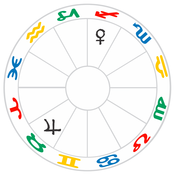Mutual Reception is when two planets are in a sign that the other rules. For example: when Venus is in Scorpio and Mars is in Libra at the same time, they are in mutual reception, using traditional rulerships.
When two planets are in mutual reception, there is a special connection between them. This may be interpreted as significant or merely interesting, depending on the astrological system used. One interpretation is that they support each other and resonate together, a bit like a conjunction. They reflect similar energies but in a mirror image kind of way.
However, there are other factors to consider. Other factors can influence how the mutual reception is likely to manifest or be experienced.
For example, just because the planets "understand each other" they still could bring out the more difficult energy in each other. An example of this is when both planets are in detriment, such as Sun in Aquarius and Saturn in Leo, of if they're in fall, like Moon in Scorpio and Mars in Cancer.
Planets in mutual reception don't have to have any aspect between them. However if they do, the nature of that aspect – easy or difficult – can influence the quality of their connection.
How long the mutual reception lasts depends on how long the planets remain in each other's sign. It can last for a couple of days when it involves the Moon, or many years if both are outer planets. An example of the latter is Uranus and Neptune. For the entire time that Uranus was in Pisces (2003 to 2011), it was in mutual reception to Neptune in Aquarius (1998-2012). These years saw a blending of these two energies through exponential development of new or improved technology (cellphones, the Internet, etc) which have blurred the lines between countries, cultures and perspectives.














